
Tom Phillips
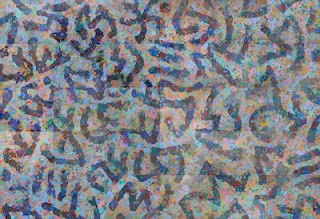
As at 9.1.09
My first (and long looked forward to) task in the business of revision is to lead a full scale attack on areas that have been irritating me for months. I had left them as they were in order to move on, but they have continued to stare at me balefully whenever I look at the picture as a whole.
The leading offender is an egregious E which seemed to suggest the possibility of literal meaning, tempting the eye to construct other latent letter forms. This has undermined the general abstraction with an unwanted false premise.
To alter it requires a kind of double-knit as a third layer of paint and pattern changes light to dark and vice versa, working one ornament within the interstices of another.
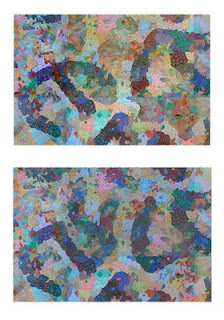
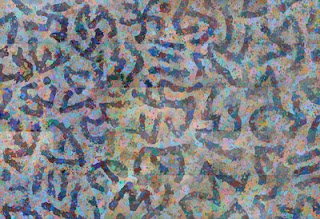
As at 23.12.08
Here as promised to myself (on target, on time though decidedly not under budget), at the end of 2008, is the first complete working of my picture. It stands like a newspaper chess problem awaiting some crucial endgame strategy. Like the Good News President I have to be black as well as white and make all the moves. So my new year's resolution is resolution itself: farewell to faintheartedness; dithering adieu.
Happy New Year to my shadow readers and as Yogi Berra said, if you see a fork in the road ahead, take it. Watch this space; things may proceed quite quickly as of now.
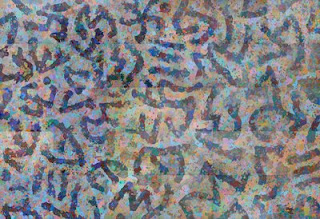
As at 16.12.08
The moment approaches when the whole surface of the picture will be finally activated. As in that last adjustment of a camera's viewfinder the entire image will suddenly be in focus and only then will I really know, without the distraction of untreated areas, what I shall have to do by way of revision and adjustment. I should reach this point by Christmas. Excitement and anxiety are mounting in tandem.
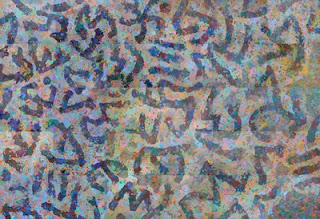
As at 5.12.2008
The scale of the bit-to-do-today, my giornato (see My painting XXVIII), has remained constant. At this stage of the picture, however, its size in proportion to the remaining area to be worked has increased enormously. At the outset, a year and a half ago, a section of fifteen or so square inches was little more than one four hundredth of the surface that lay ahead. Now, having (albeit deliberately) painted myself into a corner, each day's work is less than a tenth of what remains to be done. Soon it will be a fifth, then a half and then arrive at its own odd singularity. Which makes for nervous days. At that point the whole of the picture will be reopened and liable to revisits and revisions: the rules will change.
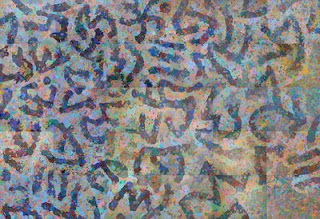
As at end October 2008
Another stimulating month at Princeton. The Institute for Advanced Study was certainly the right place to see Dr Atomic in a live telecast from the Met. Much talk from those who knew Oppenheimer (notably Freeman Dyson) and fine film of the making of the atomic bomb (Wonders Are Many). I remembered the tiny triumph of finding authentic echoes of Hiroshima for A Postcard Century. Like most new operas Adams’s latest was a quarter of an hour too long but contained some brilliant episodes; and a masterpiece aria, Batter my Heart. Gerald Finlay was superb as Oppenheimer even though (according to the Institute Director Peter Goddard) he wore the wrong hat.
Mindful of all that, it was interesting for Tarik and myself to work with Jonathan Miller on a fragment of Heart of Darkness in an old New York synagogue on the Lower East Side.
In between bouts of writing about Akan Goldweights I stared at the print out of my painting pinned up on my office blackboard. In the last week of my stay I made some pencil marks on it, erased them, made some more... until I had an idea what to do next. Now back at the studio I have the painting itself to stare at. Things are somewhat promising and I’ve started tentatively attacking the last panel again.

Pencil over printout, late Nov 2008.
The day before I left Princeton I gave a short talk about making the Abbey Memorial. Part of the title refers to Baudelaire's marvelous remark that, whatever his circumstances 'the artist feels much like a prince travelling incognito'.
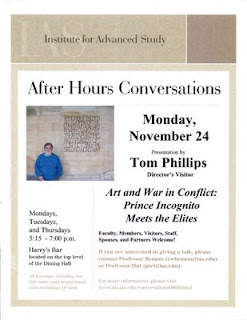

As at 31.10.2008
At art school we worked in silence. When eventually I graduated to independent studio life it occurred to me that listening to music would enhance the day: my LPs of Beethoven and Bartok string quartets could be just the thing. I was wrong. If I listened I stopped painting and if I painted I failed to listen, hearing just the first few familiar bars but only becoming aware of the piece again as the final cadence gave way to the hiss of needle on vinyl.
But priorities are priorities and I was always able to pay attention to the Test Match commentaries. Far from hindering concentration the spoken word seemed to take up the slack of a brain that would otherwise have inwardly burbled on about money and quotidien anxieties. When rain stopped play it was a double blow, although, as in winter, there was always BBC drama to look forward to after lunch.
Why not the mornings? Each day somehow seems a fresh embarkation with the chart to consult and a course to be plotted to negotiate once more the way out of dock and harbour. Towards the end of the morning (coincidentally when cricket also gets underway) the wordmind dwindles in its usefulness.
Changes in the wireless schedules drove the BBC plays to a less convenient time so I learned to record them for later consumption. Using cassettes brought me only a step away from the talking book, to which I am now addicted. Peckham library may be short on Trollope and Henry James but it is rich in literature I knew little about and I thank them for Elmore Leonard, Elizabeth Jane Howard, Lee Child, Dennis Lehane and those others who have sustained the doze-prone artist through long afternoons.
Working on this painting has clarified for me how much music is embedded in what I do and why its actual presence in the studio has never been a help. I have made drawing and paintings over the years that refer to music directly and even use the graphic devices of notation, staves, barlines, note-clusters etc. Sometimes as in Last Notes from Endenich these can arrive at a virtually playable score
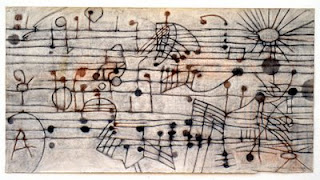
Last Notes from Endenich, pastel h75cm x w150cm 1975.
and at others, using the same elements, as in Concerto Grosso, they evoke for me an imagined music that lies, for a technically limited composer, beyond my reach to realise.
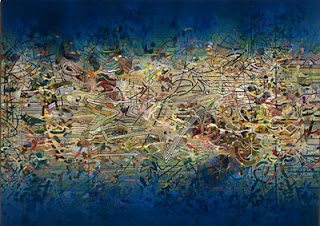
Concerto Grosso, oil on canvas h91cms x w122cms 2002.
Quantum Poetics on the other hand, while it carries no such specific baggage, has deep musical roots that have spread strongly as it has progressed. All along it has had the feel of a symphonic structure with motifs and variations. Its soundscape has suggested a divided orchestra with the dark areas represented by cellos and lower wind instruments and the lighter background provided by the higher strings and woodwind. These, which never play together, are linked by a viola and horn continuo (with interjections sometimes harsh sometimes soft from the percussion) representing the intrusions and extrusions of the main calligraphy. I do not claim that this great orchestra strikes up whenever I start to paint but often it swims into the mind's ear. More than a few times I have sung along either in my head or out loud.
Now, just as I approach the final chimes of a cadence to mark its end, I am off again to watch the red and amber leaves fall on Einstein Drive at the Institute for Advanced Study in Princeton. This will seem as if the conductor has suddenly put his baton down and quit the podium before the piece achieves its proper resolution. It is because, were he to turn the next page of the score he would find it blank. I hope to come back with the last few notes.
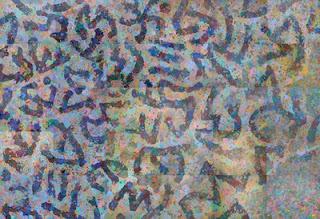
As at 17.10.2008.
To all my Canadian readers. If either of you finds yourself in Vancouver on Nov 1st you are invited to the opening of Erasures which features the whole of A Humument.
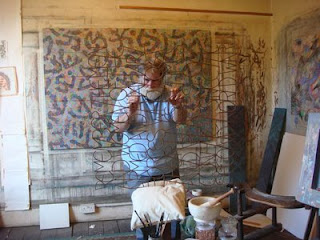
Advances on the Western front of my painting have been slowed by diversionary manoeuvres in the studio as I grapple with the last stages of preparing the memorial for Westminster Abbey. As mentioned previously we no longer speak of war. Hence this Conflict Memorial will be unveiled, with much fanfare and bemedalled dignitaries in full uniform, by a royal personage on the 29th October.
After much sieving and grinding with pestle and mortar I have my pigment ready, a mixture of earth from the world's battlefields. It is tricky to paint on round sectioned wire with its four dimensions, back, front, sides and the bit-out-of-sight-one-always-seems-to-miss.
Meanwhile at the Abbey itself, locked in a little worker's lean-to, Phil Surey is chipping away at the cloister wall to carve the lettering that frames the metal centrepiece.
It is uneasily strange to be celebrating warfare (I have not yet learned to say conflictfare) but the artistic problems remain the same; of probity in design, truth to materials and the combination of these with propriety to the subject, to present a unity.
Asked to make a statement describing the work for the upcoming occasion I tried to imagine what would make sense for the bereaved (and the comrades and friends) of the fallen, for whom the memorial should carry most meaning.
This memorial takes the form of a text (adapted from that provided by the Armed Services Memorial committee) worked in welded steel so that the letters of which it is made support and strengthen each other in free space. With this structural interdependence and the presence of steel, the generic material of ordnance, a military metaphor is tacitly present. This is symbolically reinforced by the overall covering given to the metal which is made up from earth gathered world-wide (with the assistance of travelling friends) from various sites of conflict. These date from 1066 (Battle itself) via Agincourt, the Somme and onwards to the present day. Fifteen such earth samples were mixed and ground together to make a pigment bound in colourless acrylic resin. Thus, in an echo of Rupert Brooke's famous poem, "some corner(s) of a foreign field" are brought to an appropriate place to indicate the long ancestry of national courage. The not unexpected resemblance in colour and granular texture to rust could be thought quietly to voice the artist's hope of an ultimate peace. Framing the metal sculpture and beginning similarly with the all important word 'remember' is the motto of the Armed Services Memorial Appeal carved into the fabric of the Abbey itself, a stone that is the same as that used throughout the world by the War Graves Commission. The carving is made as deep as is practicable to catch the maximum amount of defining shadow.
The services and their dead are memorialised in bonded steel, camouflaged in the earth of battle, with a surrounding call to remembrance marked in sanctified stone.
I am of course invited to the ceremony though, looking at the embossed card I am not sure what, for an artist, 'full dress uniform without sword' might be.
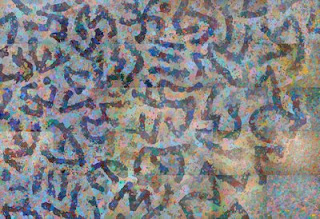
As at 1.10.08
An encouraging thing about the painting is that, for all its pleas for revision, it does begin to benefit from its barmy method of execution.
As I had hoped it really offers two distinct experiences for anyone looking at it. Moreover these almost contradictory perceptions cannot quite be had simultaneously. Thus it protects itself from at-a-glance appraisal by the casual spectator (or lazy critic).
From any distance it reads as a relatively simple image of large calligraphic shapes floating in a variegated ether of lighter colour. Close up however it presents a continuum. Both light and dark areas are inhabited by ornament on a scale that keeps itself more or less a secret from even a few feet away.
A crucial part of the game (and every work must have the combative playfulness of a game) has been, from early on, to explore what Owen Jones described in the title of his unwieldy and wonderful Victorian tome The Grammar of Ornament. I have always regarded ornament as a high art - as distinct from decoration which is added to something rather than being the matter from which it is made.
Ornament often goes hand in intricate hand with script both in the great illuminated pages of Christian illumination and the masterpieces of Arabic art which respond to the restrictive anti-representational challenge of Islam.
One of my art school tutors said of some work I was doing that it was 'just like knitting'. He meant this to be caustically damning but, as time went by, I realised that what is originally seen as a fault in one's work can be its particularity; something that should be intensified rather than adandoned. So here I am, fifty years later, knitting again and with unflagging enthusiasm for the variations that can be performed on the themes of net and maze, interlace, foliation and meander. A thousand streams of influence come into play in this abstract vocabulary.
One such I am daily reminded of at the moment as I prepare my long delayed book (promised two years ago to Hansjörg Mayer) on Akan goldweights of which I have an embarrassingly large collection. These miniature bronzes, some figurative but most abstract, were used by the Asante (Ashanti) for weighing the gold dust that was their currency for many centuries. They exhibit a rich repertoire of ornamental strategies as in this sample group of the miniature boxes (cast via the lost wax process) for carrying an individual's tiny packages of gold.
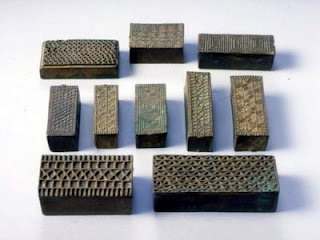
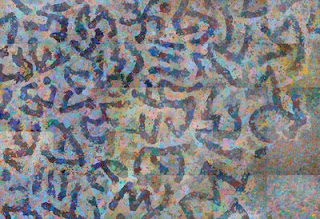
As at 23.9.08
Approaching endgame on the painting. Nervous times. There is always the fear of the image merely falling off the eastward edge it has been surging towards so slowly and for so long. The last elements have to conspire not only to sustain the momentum but to make sure the viewing eye is persuaded to travel back into the choreography of signs.
The analogy with ballet is not inappropriate: the problem on the theatre's dancing stage is to perpetuate the action: the corps de ballet has to command the whole territory. Its larger actions head towards the wings with strategies for return.
Stage, force field, battleground, microscopic slide, astronomical image, book-page, monumental inscription, diagram, weather system, planetary surface, map, musical score... all these and other ways of imagining my picture in its boundaries occur to me. Most constant is the dialogue between the microscopic and telescopic; that I am visually inhabiting either a minute event in the subatomic world or a huge one on the gigantic slow cinema screen of the cosmos. The other analogy most frequently invoked is, as here, the dance.
I once saw the dance of life and death, briefly and by accident. Opening the wrong door in an apartment block in Havana I chanced upon a young couple in a completely bare room dancing the tango to a quiet gramophone. They did not notice my entry and I watched the grey clad figures seeming to flit through each other, merging as they parted, separating as they drew together; all noiselessly with unhurried speed. After a few minutes I quietly shut the door on that entrancement but have been haunted by their magic motion ever since.
